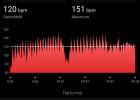How would one program Get-ups in SE?
I notice that when I do a 40 kg get up, my heart rate spikes towards 170 and the duration is ~35 seconds. So that would make it purely glycolytic.
But having purchased the SEE, I'm having difficulties to program them in a sensible manner.
I notice that when I do a 40 kg get up, my heart rate spikes towards 170 and the duration is ~35 seconds. So that would make it purely glycolytic.
But having purchased the SEE, I'm having difficulties to program them in a sensible manner.

 ) and just go with the flow
) and just go with the flow